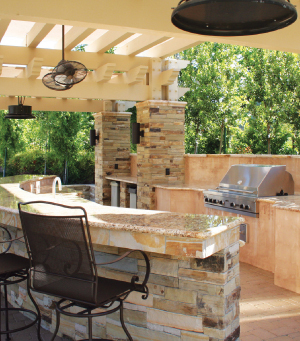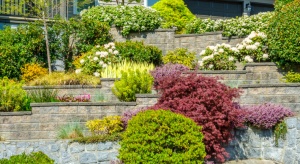YOUR HOME - EXTERIOR LOOKS
Get Outside
February, 2017 - Issue #148
 |
Best 2017
An outdoor barbecue and kitchen area will expand your living space and get you outside more often. Move on this one now so that you're space is ready for al fresco dining by spring.
Covered patios can be designed for year-round use; you can even wire them for speakers, televisions and movie projectors. With the proper weather protection, your tech will be kept water and wind free. This is a very popular home improvement; schedule yours with your landscape and design contractor now so that yours is ready to shade you from the sun by summer.
Permeable ground cover - gravels, pebbles, cobblestones, mulch, living ground covers and more - will entirely change the look and function of your space while eliminating water consumption. Plan for them in pathways, near curbs or as an alternative to concrete beneath outdoor seating areas. Permeable ground covers pair perfectly with drought-friendly plants; schedule your install for early spring so that your new additions benefit from rain and cooler temps that can assist in root development before summer.
NV Landscape, Inc. 286-8888
This Month, Why don't You...
Grow your own Food
by Tara Evans
1. Peruse Rare Seed Catalogs
Growing heirloom vegetables and fruit (Melons grow wonderfully in our heat, but do make sure you have a high-nitrogen soil supplement. They're big eaters!) is incredibly satisfying. Don't think you have the space? Trellis tomato plants next to a wall (They'll benefit from the heat blocks and brick can provide during chilly late-spring nights.) after you start your seeds in a sunny windowsill.
2. Pick & Plant a Fruit Tree
Early spring is one of the best times to plant trees; much later and your tree will compete against both the sun and the innate desire to leaf and produce fruit instead of developing roots. In an instant-gratification world, fruit trees require patience. Rarely will you eat off your tree the same year you planted it. Rush the process along by buying a healthy, large tree. Yes, you'll spend more, but you'll gain years of earlier fruit production. Just make sure that your tree's root ball has enough space in its current pot and isn't just one big tangle before you transplant. Purchasing from a reputable grower will insure that your more-mature pick will produce.
3. Choose Edible Ornamentals
If your "green thumb" is anything but, or you are incredibly tight on space or time, you can still enjoy the beauty and bounty of a garden. Plant heirloom peppers (They're gorgeous!) in pots that can adorn your front yard for a boost of color (Red, green, yellow, purple, orange!) and you'll eat mild to ultra-hot peppers until Santa Clarita gets a freeze. Tip: Peppers are slow to germinate and one of the testier plants to start from seed. Many gardeners use heating mats and start them indoors. If this is your first attempt, pick already-growing seedlings for similar enjoyment.
Green Thumb is where I purchase the majority of my seeds and all of my seedlings and trees. Their service and quality are impeccable. Green Thumb Garden Center 259-1072
 courtesy of Shutterstock |
Retaining Walls are a Necessary, Stylish Addition
for Sloped Yards
There are advantages to SCV homes with sloped yards. You're able to use the slope for trees and other landscaping that otherwise would impede uses of "flat" areas; the added height can give the illusion of a larger lot; and a slope can provide a substantial buffer between you and neighbors, adding to your sense of privacy. The downside, though, is that a slope, when not properly maintained, can aid in flooding of your yard and even the bottom floor of your house. It can also "slide," taking up more of the flat usable space at its base. An efficient, attractive retaining wall will allow you to keep the advantages of your slope while adding beauty and mitigating any harms that come with a sloped yard. Be sure that yours is built to last; it will have to "hold up" literally tens of thousands of pounds of dirt and, when it rains, water. Stacked stone, brick, block and even timber are excellent options that balance aesthetics with results.
E & J Construction & Landscape 250-1638
Now is the Best Time to Prune Trees & Shrubs
Although it may be cold outside, winter is actually the best time of year to prune your deciduous plants and shape and thin your trees and shrubs that lose their leaves in preparation for the spring months ahead. Here are several important reasons to prune at this time of the year:
• Plants are much easier to prune without their leaves
• Diseases are less likely to be transmitted in winter
• Fewer insects will be attracted to freshly-pruned vegetation
• Pruning will stimulate higher-quality fruit and flowers
• It is less stressful for the plant when you prune in the winter
It is good to have a plan and purpose in mind when pruning roses, trees or any type of vegetation. Here are some general guidelines to help you get started:
• Remove all dead and diseased wood, regardless of its location on the plant.
• Begin with larger branches and move to smaller ones, making sure to eliminate those that crisscross one another; do note that when removing a large branch, never prune to the trunk. Pruning this close can prevent the wood from healing properly.
• Starting at the center, thin the branches that are most dense but do not remove more than one quarter of the plant in one season. The purpose is to increase air circulation and develop a structure or symmetry for the plant.
Make sure to stand back and look at your pruning efforts every so often to check your progress. It is much better to remove too little than remove too much.
It's always best to consider safety while working in the garden. Protective eyewear should be worn, along with gloves to protect from thorns and prickly, dormant branches.
Castaic Lake Water Agency www.clwa.org
|
||||||||||||||||||||||||||||





